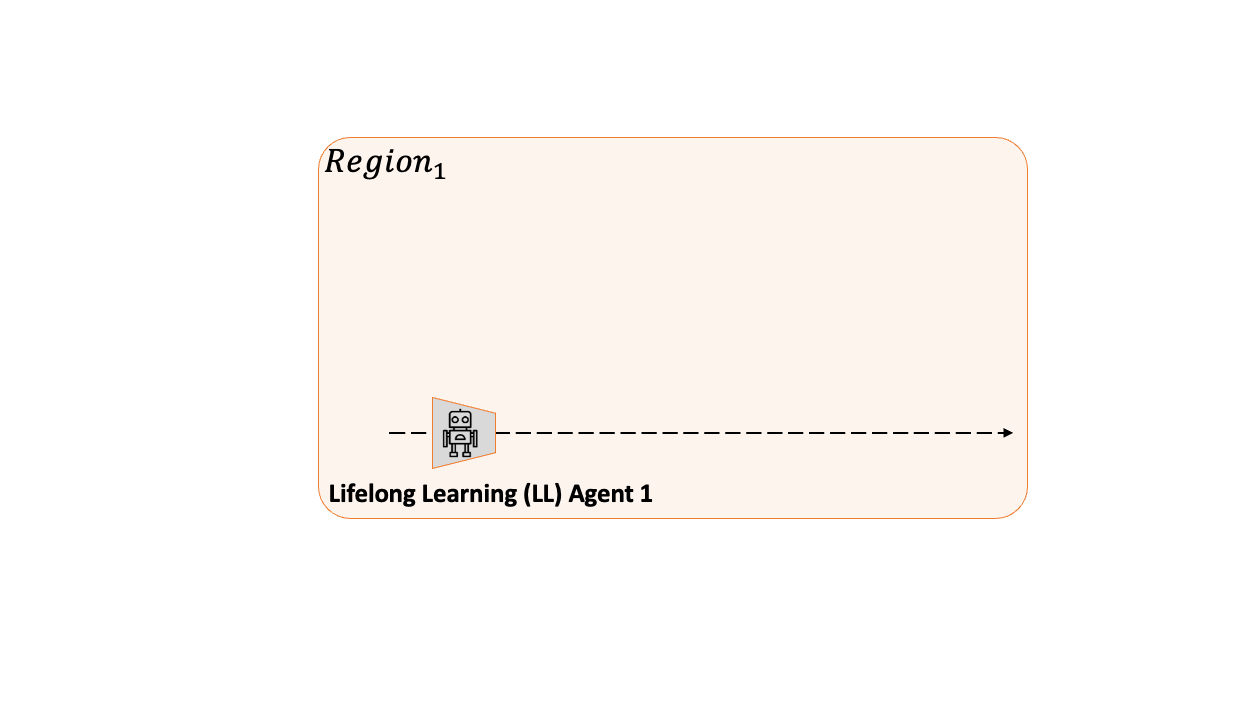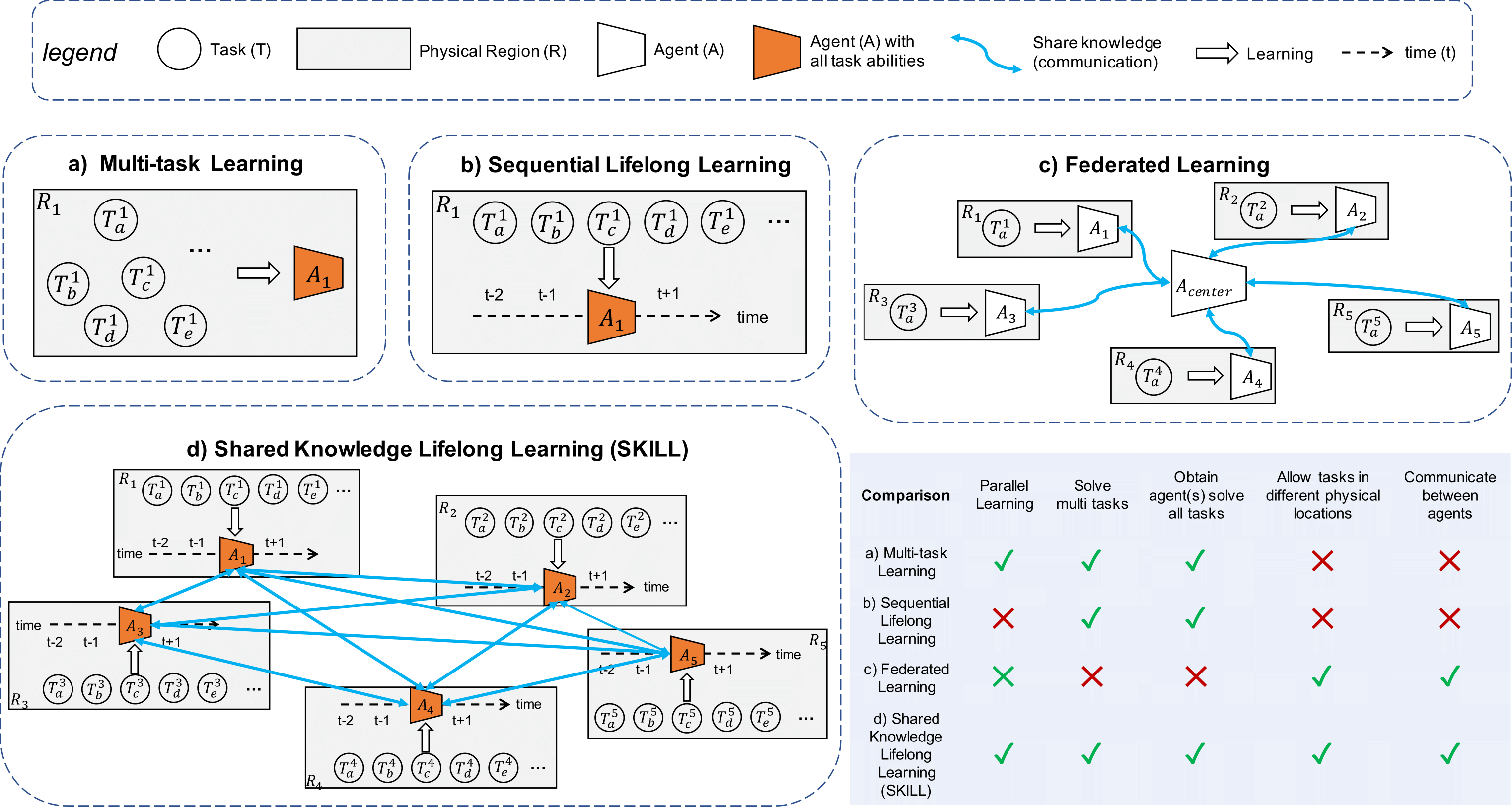Shared-Knowledge-Lifelong-Learning
[TMLR] Lightweight Learner for Shared Knowledge Lifelong Learning
Project Page | SKILL-102 dataset | Paper | Huggingface
Lightweight Learner for Shared Knowledge Lifelong Learning
Yunhao Ge, Yuecheng Li, Di Wu, Ao Xu, Adam M. Jones, Amanda Sofie Rios, Iordanis Fostiropoulos, shixian wen, Po-Hsuan Huang, Zachary William Murdock, Gozde Sahin, Shuo Ni, Kiran Lekkala, Sumedh Anand Sontakke, Laurent Itti
Transactions on Machine Learning Research
Figure: SKILL vs. related learning paradigms. a) Multi-task learning (Caruana, 1997): one agent learns all tasks at the same time in the same physical location. b) Sequential Lifelong Learning (S-LL) (Li & Hoiem, 2017): one agent learns all tasks sequentially in one location, deploying LL-specific machinery to avoid task interference. c) Federated learning (McMahan et al., 2017): multiple agents learn the same task in different physical locations, then sharing learned knowledge (parameters) with a center agent. d) Our SKILL: different S-LL agents in different physical regions each learn tasks, and learned knowledge is shared among all agents, such that finally all agents can solve all tasks. Bottom-right table: Strengths & weaknesses of each approach
Figure: A visual comparison between SKILL-102 with previous continual learning benchmark: (a) SKILL-102 dataset visualization. Task difficulty (y-axis) was estimated as the error rate of a ResNet-18 trained from scratch on each task for a fixed number of epochs. Circle size reflects dataset size (number of images). (b) Comparison with other benchmark datasets including Visual Domain Decathlon (Rebuffi et al., 2017a), Cifar-100 (Krizhevsky et al., 2009), F-CelebA (Ke et al., 2020), Fine-grained 6 tasks (Russakovsky et al., 2014) (Wah et al., 2011), (Nilsback & Zisserman, 2008b), (Krause et al., 2013), (Saleh & Elgammal, 2015), (Eitz et al., 2012) c) Qualitative visualization of other datasets, using the same legend and format as in a).
We have proposed a new framework for shared-knowledge, parallelized LL. On a new, very challenging SKILL-102 dataset, we find that this approach works much better than previously SOTA baselines, and is much faster. Scaling to > 500 difficult tasks like the ones in our new SKILL-102 dataset seems achievable with the current implementation.
Figure: Algorithm design. Top: overall pipeline, where agents are deployed in different regions to learn their own tasks. Subsequently, learned knowledge is shared among all agents. Bottom: Zoom into the details of each agent, with 4 main roles: 1) Training: agents use a common pre-trained and frozen backbone, stored in ROM memory at manufacturing time (gray trapezoid with lock symbol). The backbone allows the agent to extract compact representations from inputs (e.g., with an xception backbone, the representation is a latent vector of 2048 dimensions, and inputs are 299 × 299 RGB images). Each agent learns a task-specific head (red triangle) for each new task. A head consists of the last fully-connected layer of the network plus our proposed LL beneficial biasing units (BB) that provide task-dependent tuning biases to all neurons in the network (one float number per neuron). During training, each agent also learns a GMMC or Mahalanobis task anchor which will form a task mapper. 2) Share knowledge with other agents: each agent shares the learned task-specific head, Beneficial Bias (BB), and GMMC module (or training images for Mahalanobis) with all other agents. 3) Receive knowledge from other agents: each agent receives different heads and GMMC/Mahalanobis task mapper anchors from other agents. All heads are stored in a head bank and all task anchors are consolidated to form a task mapper. 4) Testing: At test time, an input is first processed through the task mapper. This outputs a task ID, used to load up the corresponding head (last layer + beneficial biases) from the bank. The network is then equipped with the correct head and is run on the input to produce an output.
Figure: Result of our method compare to previous continual learning benchmark. Average absolute accuracy on all tasks learned so far, as a function of the number of tasks learned. Our LLL approach is able to maintain higher average accuracy than all baselines. BB provides a small but reliable performance boost (LLL w/BB vs. LLL w/o BB). The sharp decrease in early tasks carries no special meaning except for the fact that tasks 4,8,10 are significantly harder than the other tasks in the 0-10 range, given the particular numbering of tasks in SKILL-102. Note how again SUPSUP has a low accuracy for the very first task. This is because of the nature of its design; indeed, SUPSUP is able to learn some other tasks in our sequence with high accuracy.
Getting starged
Installation(single file)
git clone https://github.com/gyhandy/Shared-Knowledge-Lifelong-Learning.git
Download file
Single file downloading option (~1.6T)
wget http://ilab.usc.edu/andy/skill-dataset/skill/SKILL-Dataset-backend.zip
unzip SKILL-Dataset-backend.zip
Multiple files downloading option(~600G per file)
wget http://ilab.usc.edu/andy/skill-dataset/separate-v/skill-dataset.z01
wget http://ilab.usc.edu/andy/skill-dataset/separate-v/skill-dataset.z02
wget http://ilab.usc.edu/andy/skill-dataset/separate-v/skill-dataset.zip
unzip skill-dataset.zip
General directory structure
-
dataset/contains code for declaretrain_datasets,val_datasets,train_loaders, andval_loadersfor the DCT dataset, each is a list of 107 datasets contains in the DCT. You can also define your owntrain_datasets,val_datasets,train_loaders, andval_loadersfor your own datasets. Place to change is commented in the main code -
Xception_src/contains models and specific customized layer used in the experiment -
gmmc_grid_search/contains the GMMC classifier -
main.py/The main code needs to be run
Usage
argument
-
--resultthe result path will store all the logs -
--weightthe weight path which store the weight of the classifiers -
--predictionthe folder to store the prediction results for each instance in the dataset -
--datathe path to store the data, this should be where you unzip before -
--methodBB_SKILLrefers to the BB network mentioned in the paper andLinear_SKILLrefers to the linear classifier with a fixed backbone -
--task_mappertypes of task mapper, eitherGMMCorMAHA -
--n_cnumber of clusters used forGMMC -
--activation_sizethe size of the activation vector (e.g. resnet18 has size 512 and resnet 50 has size 2048)
Sample run
- To run a BB network with GMMC
python main.py --data <Folder where you unzip>
The result can be found in Table 1. Row 2
- To run a Linear Classifier with GMMC
python main.py --method Linear_SKILL --data <Folder where you unzip>
The result can be found in Table 1. Row 1
- To run a BB network with Mahalanobis
python main.py --data <Folder where you unzip> --task_mapper MAHA
The result can be found in Table 1. Row 4
- To run a Linear Classifier with Mahalanobis
python main.py --method Linear_SKILL --data <Folder where you unzip> --task_mapper MAHA
The result can be found in Table 1. Row 3
The code will learn 102 small and separte heads(either a linear head or a linear head with a task bias) for each tasks respectively in order. This step can be parallized on multiple GPUS with one task per GPU. The heads will be saved in the weight folder. After that, the code will learn a task mapper(Either using GMMC or Mahalanobis) to distinguish image task-wisely. Then, all images will be evaluated in the same time without a task label.


